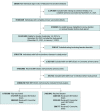Assessment of Heterologous and Homologous Boosting With Inactivated COVID-19 Vaccine at 3 Months Compared With Homologous Boosting of BNT162b2 at 6 Months
- PMID: 35947381
- PMCID: PMC9366545
- DOI: 10.1001/jamanetworkopen.2022.26046
Assessment of Heterologous and Homologous Boosting With Inactivated COVID-19 Vaccine at 3 Months Compared With Homologous Boosting of BNT162b2 at 6 Months
Abstract
Importance: Evidence for the timing of booster vaccination after completion of BNT162b2 and CoronaVac primary vaccination is crucial to guide policy recommendations.
Objective: To compare the odds of symptomatic SARS-CoV-2 infection and COVID-19-related outcomes after heterologous and homologous boosting of CoronaVac at 3-month intervals and homologous boosting of BNT162b2 at 6-month intervals, with BNT162b2 primary series (2 doses) as the reference group.
Design, setting, and participants: This population-based retrospective cohort study used national data for Malaysia. Participants included all individuals aged 18 years and older who received a complete primary series of CoronaVac or BNT162b2 vaccine and were eligible for a booster dose between November 21, 2021, and December 28, 2021. Data were analyzed from November 21, 2021, to January 7, 2022.
Exposures: Receipt of a booster vs no booster and categorized into primary series BNT162b2 (2 doses of BNT162b2), primary series CoronaVac (2 doses of CoronaVac), 3 doses of BNT162b2, primary series CoronaVac plus a BNT162b2 booster, and 3 doses of CoronaVac.
Main outcomes and measures: The primary outcome was symptomatic SARS-CoV-2 infection. The secondary outcomes were COVID-19-related intensive care unit admission and death. All outcomes were observed from the day an individual was considered fully boosted (≥14 days after booster dose).
Results: Our cohort included 13 840 240 individuals (mean [SD] age, 39.9 [15.5] years; 7 040 298 [50.9%] men; 4 451 180 individuals [32.2%] with ≥1 comorbidities), of whom 5 081 641 individuals (36.7%) had received a booster dose. Using the primary series BNT162b2 recipients as reference, the adjusted odds against symptomatic SAR-CoV-2 infection were lower for individuals who received the primary series CoronaVac plus a BNT162b2 (adjusted odds ratio [aOR], 0.06 [95% CI, 0.05-0.06]), 3 doses of CoronaVac (aOR, 0.08 [95% CI, 0.06-0.10]), or 3 doses of BNT162b2 (aOR, 0.01 [95% CI, 0.00-0.01]). Receipt of heterologous booster (primary series of CoronaVac plus a BNT162b2 booster) was associated with lower odds of SARS-CoV-2 infection (aOR, 0.17 [95% CI, 0.17-0.18]) compared with homologous booster (3 doses of CoronaVac) for individuals aged 60 years and older (aOR, 0.19 [95% CI, 0.19-0.20]).
Conclusions and relevance: In this cohort study, for individuals who received the CoronaVac primary series and a booster dose of BNT162b2 or CoronaVac at 3 months, the observed odds of symptomatic SARS-CoV-2 infection were similar to individuals who received the BNT162b2 primary series plus a third dose of BNT162b2 at 6 months. Heterologous booster is recommended for individuals aged 60 years or older who received the CoronaVac primary series, given the lower observed odds against symptomatic SARS-CoV-2 infection among those who received a BNT1612b2 booster.
Conflict of interest statement
Figures
References
-
- Thompson MG, Natarajan K, Irving SA, et al. . Effectiveness of a third dose of mRNA vaccines against COVID-19–associated emergency department and urgent care encounters and hospitalizations among adults during periods of Delta and Omicron variant predominance - VISION Network, 10 states, August 2021-January 2022. MMWR Morb Mortal Wkly Rep. 2022;71(4):139-145. doi:10.15585/mmwr.mm7104e3 - DOI - PMC - PubMed
MeSH terms
Substances
LinkOut - more resources
Full Text Sources
Medical
Miscellaneous



